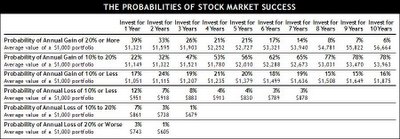
Time Can help You Cut Down Your Risk
Even after the bear market of 2000-2002, the stock market has returned, on average, about 12% per year since World War II. That's for a portfolio that is one-half large company stocks and one-half small company stocks (using the data from Ibbotson Associates, an industry leader in compiling market statistics). This assumes all dividends were reinvested and ignores the unfortunate fact that in real life Uncle Sam steps in and confiscates a hefty portion of your gains.
Of course, knowing the market's average return has been 12% annually doesn't tell you what the return will be this year. Such an average obscures some pretty wild rides along the way (such as twelve-month periods where losses were as horrifying as 36% and gains were as breathtaking as 79%). In fact, only about 4% of the time have stocks actually returned 12% (give or take 1%) in a twelve-month period.
What it does tell you, however, is that time is on the side of the long-term investor. The longer you are willing to keep your money in the stock market, the greater your likelihood of success. According to the Ibboston data, if you picked any 12-month period at random since World War II to own stocks, you had a 78% chance of making money. How much money? Study the historical evidence in the table. You would have had about a 39% probability of making 20% or more, a 22% chance of making 10%-20%, and a 17% chance of earning 1%-10%.
The numbers presented here are based on "rolling" periods. After looking at the results from holding periods that began on January 1, I then "rolled" to the next month to see what happened if the holding period had begun on February 1. And so on through the year. This gives a better understanding of the extremes you might expect.
Notice that only 9% of the three-year holding periods lost money. In other words, if you held your stocks for at least three years, you raised your likelihood of making money to 91%! You can see that as the holding period increases, the very large gains and losses gradually disappear as the market moves closer to its long-term historical average. More importantly, by the time you reach a four-year holding period, any losses you experience are likely to be minor. After eight years, the losses have stopped altogether.
How can you apply this? By aligning your investment expectations accordingly. Begin judging your investment progress in terms of the market's long-term average annual return and how much time remains before you will need to sell your holdings. It may be that, on occasion, your mutual fund portfolio will show far greater growth than 12% annually (as it did last year). Don't expect this to continue indefinitely. Recognize it for what it is — one of those above-the-norm results. Your additional profits will provide you with a cushion in case the market is not as kind to you this year.
On the other hand, if you finish this year ahead only +4%, don't despair. You would temporarily be "behind schedule" with respect to your 12% goal, but as long as you still have many years remaining in your expected holding period, you still have the odds in your favor. You should hang in there and wait for the stock market to do what it has always done in the past — reward the patient investor.
In closing, let me say that investors should take on the higher risks of owning stocks only because they need the higher returns they offer. My advice is that you not take on any more risk than necessary, that is, that you invest at the lowest level of stock exposure consistent with achieving your growth and income goals.
By Austin Pryor
http://www.soundmindinvesting.com/
